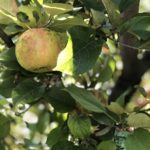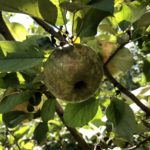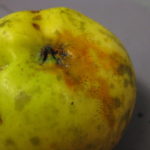The symptoms of sooty blotch and flyspeck (SBFS) have begun to make their appearance. I know this because 1). I’m starting to see spots (Fig 1, 2 & 3). We have accumulated MORE THAN enough hours of post- petal fall leaf wetness needed for infection to occur, despite the sudden drought conditions.
First, what is enough hours of post- petal fall leaf wetness needed for infection to occur? Different states have developed different levels and standards, with highs of 270 hours (hours must be greater than 4 hrs to be counted) needed in North Carolina, compared to 175 period identified in Iowa. In Kentucky, John Hartman found 185-251 hours were needed, but did not stipulate that a minimum of 4 hrs was required to accumulate leaf wetness. We have not yet developed a guideline for Indiana. In the interim, using either the Iowa or Kentucky model may reduce your fungicide usage in a normal year. For much of Indiana, ‘normal’ is a state we hear about—a fictional place between our extremes of tropical rainforest (2015, 2016, 2018, 2019) and drought (2012, the last few weeks) that we very rarely ever experience!
Sprays: Topsin-M tanked with captan is an effective combination (Ziram is another option, FRAC M; 14 d PHI). However, some orchards may be experiencing Topsin-M resistant flyspeck and sooty blotch populations. If you suspect you are one of those orchards with SBFS fungicide resistance, or you were late getting started, use Flint (FRAC 11), Pristine (FRAC 7-11), or Merivon (FRAC 7-11) to eradicate any infections that may have already started. Thereafter, captan with a phosphorous acid fungicide like Agrifos, Aliette, Rampart (and other FRAC 33s), or even just an acidifier like LI700 at appropriate intervals (2 weeks or 2 inches of rain; 10 days or 1.5 inches of rain) should provide fair to good control. If disease pressure is high, and you haven’t exceeded your four applications of strobies, Flint (14 day PHI), Pristine, or Merivon all provide the best protection against this disease complex, and several of the summer rots. We do not know if these fungicides are protecting against the disease, or are effective eradicants, but we do know that they work quite well against this complex.
- Figure 1. Early SBFS symptoms on Honeycrisp. Photo by Janna Beckerman.
- Figure 2. Later SBFS symptoms on Honeycrisp. Fruit produced in poorly pruned trees are more prone to infection. Photo by Janna Beckerman.
- Figure 3. Although the names and fungal growth may appear different between fly speck and sooty blotch, this apple may be infected by the same fungus, or 20 different fungi! The answer to what species is infecting this apple is hidden in its DNA. Photo by Janna Beckerman.


